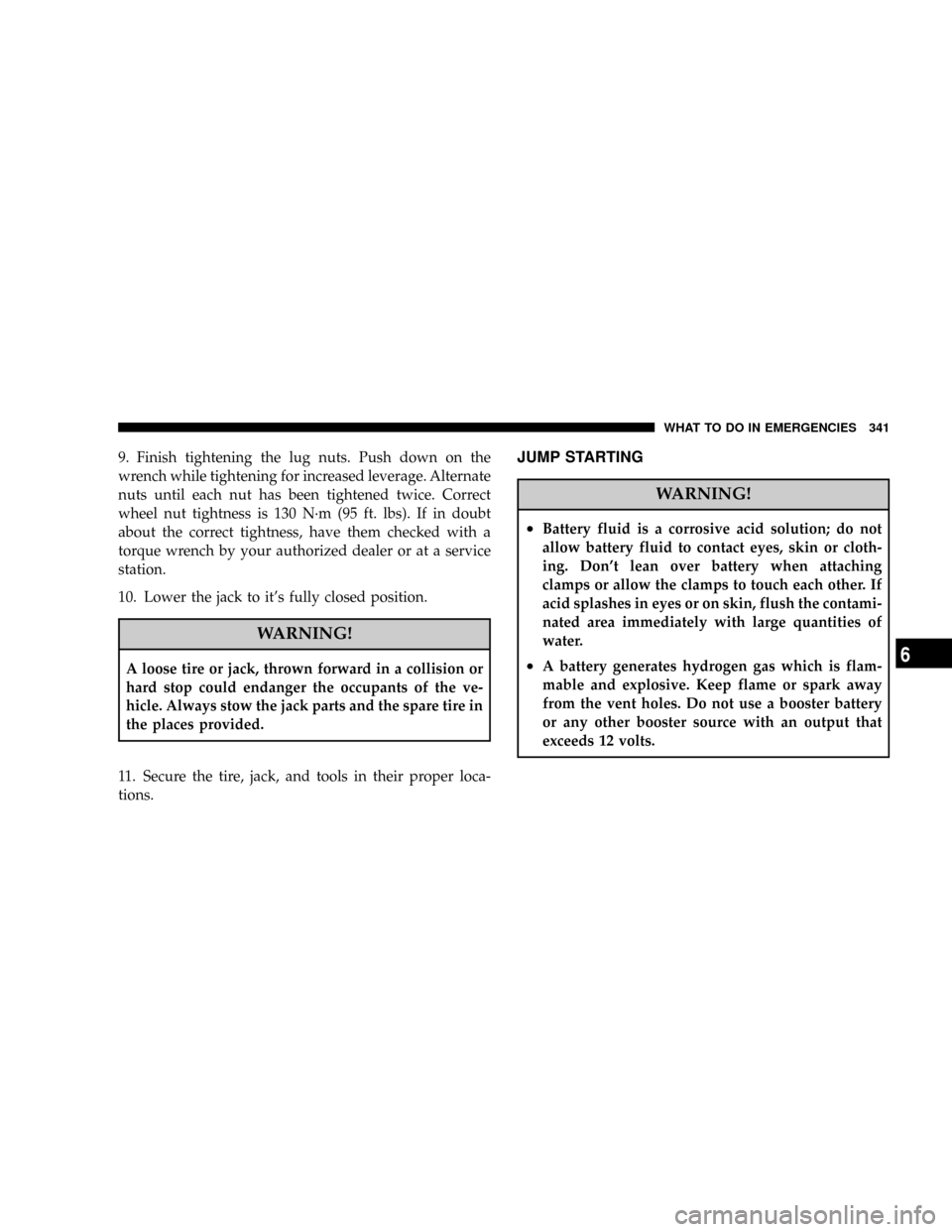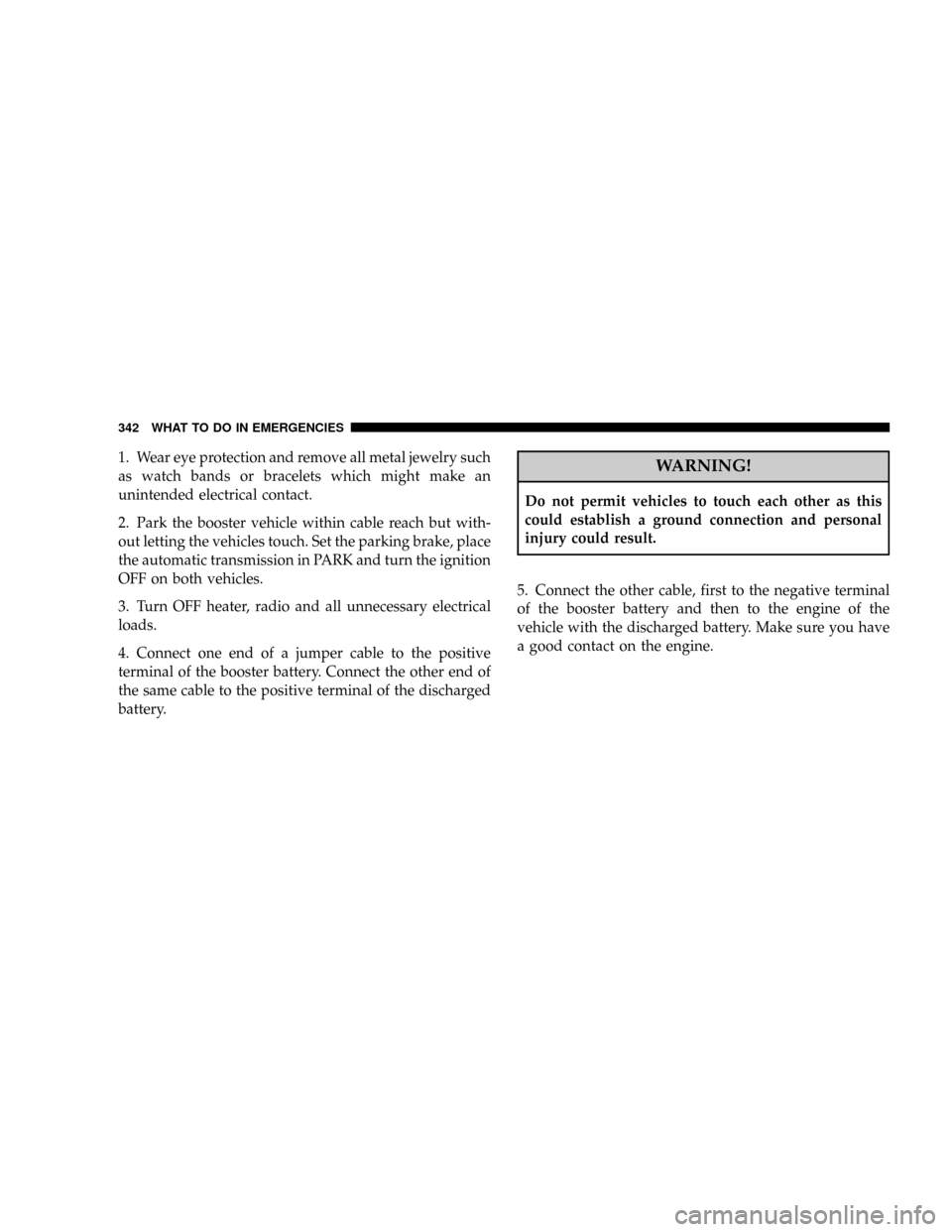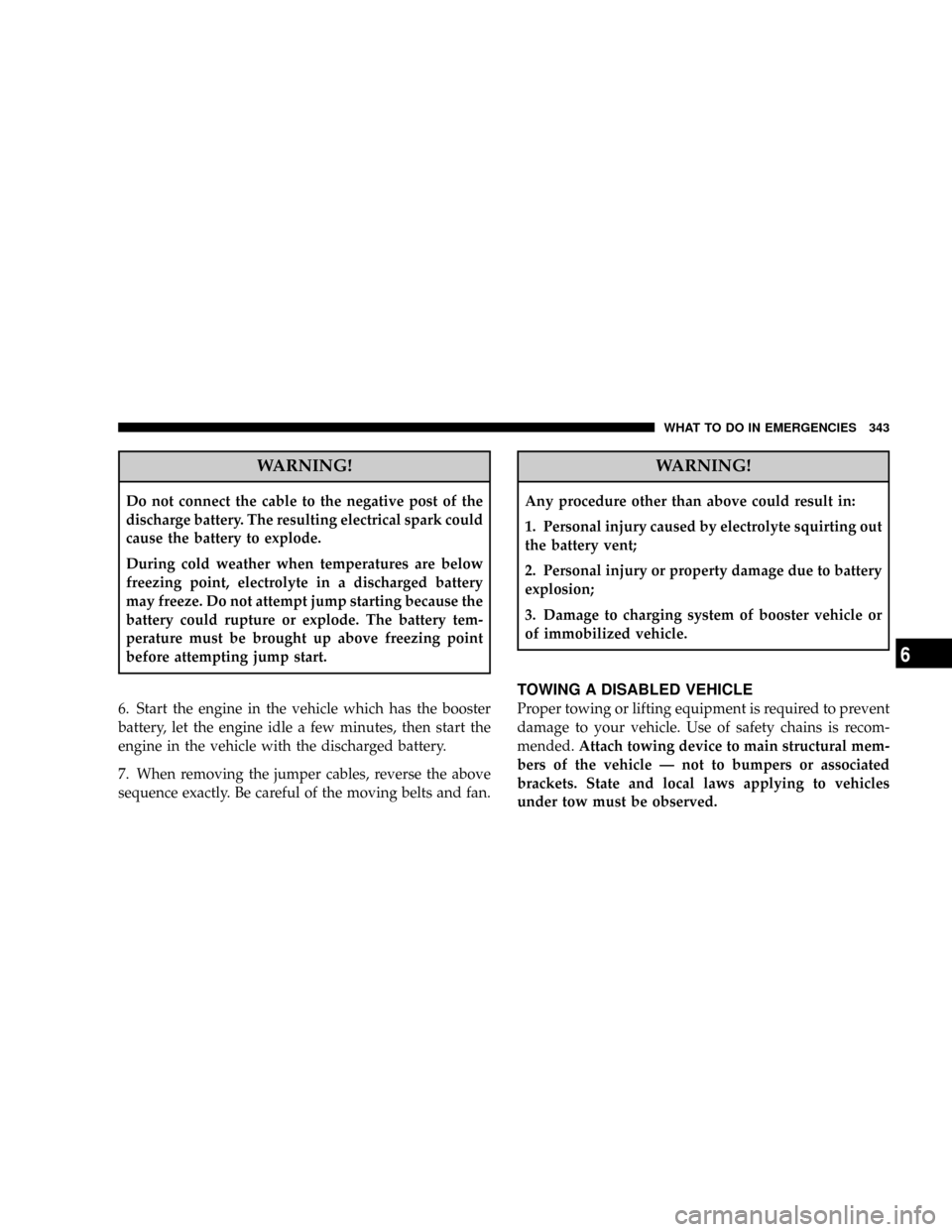DODGE NITRO 2008 1.G Owners Manual
Manufacturer: DODGE, Model Year: 2008, Model line: NITRO, Model: DODGE NITRO 2008 1.GPages: 434, PDF Size: 6.2 MB
Page 341 of 434

9. Finish tightening the lug nuts. Push down on the
wrench while tightening for increased leverage. Alternate
nuts until each nut has been tightened twice. Correct
wheel nut tightness is 130 N´m (95 ft. lbs). If in doubt
about the correct tightness, have them checked with a
torque wrench by your authorized dealer or at a service
station.
10. Lower the jack to it's fully closed position.
WARNING!
A loose tire or jack, thrown forward in a collision or
hard stop could endanger the occupants of the ve-
hicle. Always stow the jack parts and the spare tire in
the places provided.
11. Secure the tire, jack, and tools in their proper loca-
tions.
JUMP STARTING
WARNING!
²Battery fluid is a corrosive acid solution; do not
allow battery fluid to contact eyes, skin or cloth-
ing. Don't lean over battery when attaching
clamps or allow the clamps to touch each other. If
acid splashes in eyes or on skin, flush the contami-
nated area immediately with large quantities of
water.
²A battery generates hydrogen gas which is flam-
mable and explosive. Keep flame or spark away
from the vent holes. Do not use a booster battery
or any other booster source with an output that
exceeds 12 volts.
WHAT TO DO IN EMERGENCIES 341
6
Page 342 of 434

1. Wear eye protection and remove all metal jewelry such
as watch bands or bracelets which might make an
unintended electrical contact.
2. Park the booster vehicle within cable reach but with-
out letting the vehicles touch. Set the parking brake, place
the automatic transmission in PARK and turn the ignition
OFF on both vehicles.
3. Turn OFF heater, radio and all unnecessary electrical
loads.
4. Connect one end of a jumper cable to the positive
terminal of the booster battery. Connect the other end of
the same cable to the positive terminal of the discharged
battery.WARNING!
Do not permit vehicles to touch each other as this
could establish a ground connection and personal
injury could result.
5. Connect the other cable, first to the negative terminal
of the booster battery and then to the engine of the
vehicle with the discharged battery. Make sure you have
a good contact on the engine.
342 WHAT TO DO IN EMERGENCIES
Page 343 of 434

WARNING!
Do not connect the cable to the negative post of the
discharge battery. The resulting electrical spark could
cause the battery to explode.
During cold weather when temperatures are below
freezing point, electrolyte in a discharged battery
may freeze. Do not attempt jump starting because the
battery could rupture or explode. The battery tem-
perature must be brought up above freezing point
before attempting jump start.
6. Start the engine in the vehicle which has the booster
battery, let the engine idle a few minutes, then start the
engine in the vehicle with the discharged battery.
7. When removing the jumper cables, reverse the above
sequence exactly. Be careful of the moving belts and fan.
WARNING!
Any procedure other than above could result in:
1. Personal injury caused by electrolyte squirting out
the battery vent;
2. Personal injury or property damage due to battery
explosion;
3. Damage to charging system of booster vehicle or
of immobilized vehicle.
TOWING A DISABLED VEHICLE
Proper towing or lifting equipment is required to prevent
damage to your vehicle. Use of safety chains is recom-
mended.Attach towing device to main structural mem-
bers of the vehicle Ð not to bumpers or associated
brackets. State and local laws applying to vehicles
under tow must be observed.
WHAT TO DO IN EMERGENCIES 343
6
Page 344 of 434

NOTE:Transmission must be in ªNº (Neutral) under
any towing configuration.
Two-Wheel Drive Vehicles
Front Wheels Raised
The speed mustnotexceed 30 mph (50 km/h) and the
distance mustnotexceed 15 miles (25 km).
This vehicle may be towed with the transmission in ªNº,
the ignition key in the LOCK position, the front wheels
raised, and the rear wheels on the ground.
NOTE:Towing the vehicle, with the rear wheels on the
ground, at more than 30 mph (50 km/h) or for more than
15 miles (25 km) can cause severe transmission damage.
If the vehicle is to be towed more than 15 miles (25 km )
or faster than 30 mph, it must be towed on a flatbed.
Rear Wheels Raised
The speed mustnotexceed 30 mph (50 km/h) and the
distance mustnotexceed 15 miles (25 km).
This vehicle may be towed with the transmission in ªNº,
the ignition key in the LOCK position, the rear wheels
raised, and the front wheels on the ground.
If the vehicle is to be towed more than 15 miles (25 km )
or faster than 30 mph, it must be towed on a flatbed.
Four-Wheel Drive Vehicles
The manufacturer recommends flatbed towing with all
wheelsOFFthe ground.
344 WHAT TO DO IN EMERGENCIES
Page 345 of 434

MAINTAINING YOUR VEHICLE
CONTENTS
mEngine Compartment ± 3.7L...............348
mEngine Compartment ± 4.0L...............349
mOnboard Diagnostic System Ð OBD II........350
NLoose Fuel Filler Cap Message............351
mEmissions Inspection And Maintenance
Programs............................351
mReplacement Parts......................353
mDealer Service.........................353
mMaintenance Procedures..................354NEngine Oil..........................354
NDrive Belts Ð Check Condition And Tension . . 358
NSpark Plugs.........................358
NCatalytic Converter....................359
NCrankcase Emission Control System........361
NFuel Filter..........................361
NEngine Air Cleaner Filter................361
NMaintenance-Free Battery................362
NAir Conditioner Maintenance.............362
7
Page 346 of 434

NPower Steering Fluid Check..............363
NDriveline And Steering Component
Lubrication..........................364
NBody Lubrication.....................364
NWindshield Wiper Blades................365
NWindshield Washers...................365
NExhaust System......................366
NCooling System.......................366
NHoses And Vacuum/Vapor Harnesses.......371
NBrake System........................372
NAutomatic Transmission................374
NHydraulic Clutch Fluid Ð Manual
Transmission........................375
NManual Transmission..................375NTransfer Case........................376
NFront/Rear Axle Fluid..................377
NAppearance Care And Protection From
Corrosion...........................377
mFuses (Integrated Power Module)...........381
mReplacement Light Bulbs.................389
mBulb Replacement......................389
NHead Light..........................389
NLeft Front Turn Signal..................390
NRight Front Turn Signal.................391
NFront Side Marker.....................391
NFront Fog Light (Front Fascia Mounted).....391
NRear Tail, Stop, Turn Signal, And Back-Up
Lights.............................392
346 MAINTAINING YOUR VEHICLE
Page 347 of 434

NCenter High Mounted Stop Light (CHMSL) . . . 393
mFluid Capacities........................394
mFluids, Lubricants And Genuine Parts........395NEngine.............................395
NChassis............................396
MAINTAINING YOUR VEHICLE 347
7
Page 348 of 434

ENGINE COMPARTMENT ± 3.7L
348 MAINTAINING YOUR VEHICLE
Page 349 of 434

ENGINE COMPARTMENT ± 4.0L
MAINTAINING YOUR VEHICLE 349
7
Page 350 of 434

ONBOARD DIAGNOSTIC SYSTEM Ð OBD II
Your vehicle is equipped with a sophisticated onboard
diagnostic system called OBD II. This system monitors
the performance of the emissions, engine, and automatic
transmission control systems. When these systems are
operating properly, your vehicle will provide excellent
performance and fuel economy, as well as engine emis-
sions well within current government regulations.
If any of these systems require service, the OBD II system
will turn on the ªMalfunction Indicator Light.º It will
also store diagnostic codes and other information to
assist your service technician in making repairs. Al-
though your vehicle will usually be drivable and not
need towing, see your dealer for service as soon as
possible.CAUTION!
²Prolonged driving with the ªMalfunction Indica-
tor Lightº on could cause further damage to the
emission control system. It could also affect fuel
economy and driveability. The vehicle must be
serviced before any emissions tests can be per-
formed.
²If the ªMalfunction Indicator Lightº is flashing
while the engine is running, severe catalytic con-
verter damage and power loss will soon occur.
Immediate service is required.
350 MAINTAINING YOUR VEHICLE